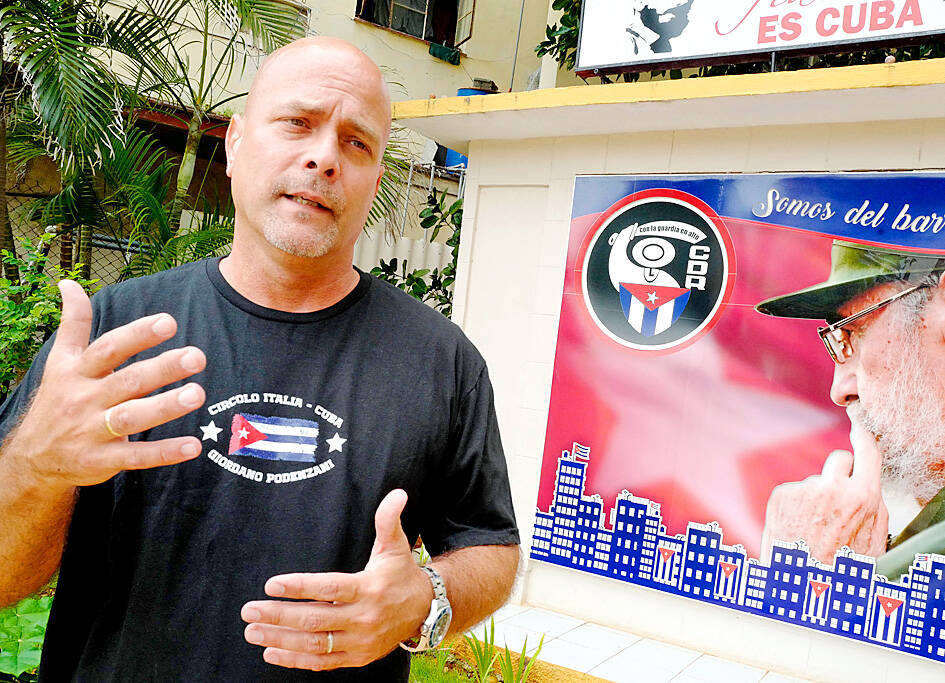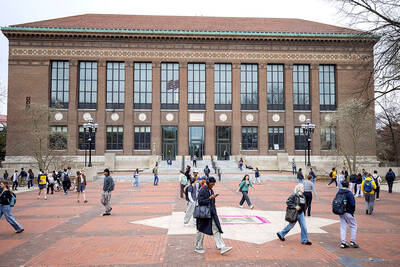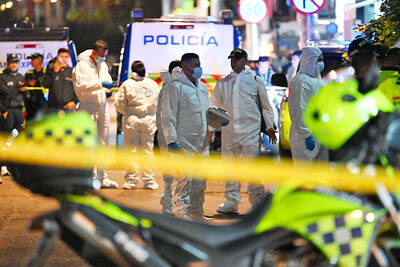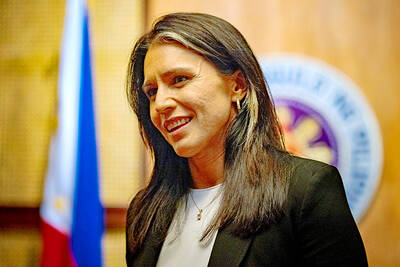In Cuba, thousands of neighborhood cells set up as the eyes and ears of Fidel Castro’s communist revolution are trying to find ways to lure young people who have little interest in the cause.
It has been six decades since Castro created the Committees for the Defense of the Revolution (CDR) to keep watch for his then-shaky government, and the 138,000 committees remain an enduring symbol of communism on the island.
However, enthusiasm for the neighborhood associations has waned in the past few years, especially after the COVID-19 pandemic, the boosting of US sanctions and a severe economic crisis that has eroded purchasing power.

Photo: AFP
“The new generation wants nothing to do with all that,” a female student said, asking not to be named.
Every citizen automatically becomes a member at 14, but getting them to engage is a challenge.
“Today, young people sleep with their phone in their pocket, and as soon as they turn it on, there is a media bombardment against our [socialist] process,” CDR national coordinator Gerardo Hernandez, 58, said.
He was one of the “Cuban Five” spies who were imprisoned in the US in 1998, and whose release helped pave the way for a 2014 thaw in ties between the Cold War foes.
A local hero, he has been given the tricky task of revitalizing the committees, at a time when the nation is undergoing a transformation, opening up to private small businesses, allowing citizens to buy and sell houses, and the arrival of Internet access.
At the same time, hundreds of thousands of Cubans have fled the economic crisis.
“We are trying to reverse this situation and make young people understand that the CDRs offer them an extraordinary opportunity to develop their vocation and to have an influence on their community,” Hernandez said, as the CDR held its tenth annual congress last month, at which it held a debate on how to make the cells “attractive to young people.”
Initially set up as a surveillance network to denounce “counter-revolutionaries,” the CDRs organize community projects and coordinate services such as vaccination campaigns and blood drives.
The defense committees are particularly visible during elections, presiding over neighborhood meetings and scrupulously controlling citizens’ participation. Surveillance is still a key part of their work, and they keep a lookout for drug trafficking, tax evasion and other crimes.
Cells exist in every neighborhood and village, and the government counts about 8 million members — more than three-quarters of the nation’s population — including those who are not active.
Manuel Cuesta Morua is a dissident who faced “acts of repudiation” in the 2000s, when large groups of CDR members would verbally and physically abuse opponents.
“Young people today are much more pragmatic, much more transactional,” Cuesta Morua said. “They participate when it is to their advantage.”
“The youth are apolitical, they don’t identify with the government, which they associate with the CDR,” he added.
He said that no one in his family had taken over from his mother, who he described as a “CDR activist.”
Seated at a cafe in Old Havana, Lazaro, 43, who did not want to give his last name, criticized the association.
“The CDR has never helped me. I always had to get by on my own,” Lazaro said.
Every year, on the night of Sept. 27, CDR members get together in their neighborhood for a party around a stew cooked on an open fire. Everyone brings what they can.
Ernesto Lemus, 56, president of a CDR in Old Havana, said the party was an important “continuity” of the 1959 revolution, which saw a radical shift to communism, heightening tensions with the US during the Cold War.
“A few years ago, it was a party, but not anymore. Today there is nothing and everything is expensive, there is no more unity in this regard,” said gardener Rafael Caballero Lopez, 35, who is planning to emigrate to Colombia.

Swedish campaigner Greta Thunberg was deported from Israel yesterday, the Israeli Ministry of Foreign Affairs said, the day after the Israeli navy prevented her and a group of fellow pro-Palestinian activists from sailing to Gaza. Thunberg, 22, was put on a flight to France, the ministry said, adding that she would travel on to Sweden from there. Three other people who had been aboard the charity vessel also agreed to immediate repatriation. Eight other crew members are contesting their deportation order, Israeli rights group Adalah, which advised them, said in a statement. They are being held at a detention center ahead of a

A Chinese scientist was arrested while arriving in the US at Detroit airport, the second case in days involving the alleged smuggling of biological material, authorities said on Monday. The scientist is accused of shipping biological material months ago to staff at a laboratory at the University of Michigan. The FBI, in a court filing, described it as material related to certain worms and requires a government permit. “The guidelines for importing biological materials into the US for research purposes are stringent, but clear, and actions like this undermine the legitimate work of other visiting scholars,” said John Nowak, who leads field

‘THE RED LINE’: Colombian President Gustavo Petro promised a thorough probe into the attack on the senator, who had announced his presidential bid in March Colombian Senator Miguel Uribe Turbay, a possible candidate in the country’s presidential election next year, was shot and wounded at a campaign rally in Bogota on Saturday, authorities said. His conservative Democratic Center party released a statement calling it “an unacceptable act of violence.” The attack took place in a park in the Fontibon neighborhood when armed assailants shot him from behind, said the right-wing Democratic Center, which was the party of former Colombian president Alvaro Uribe. The men are not related. Images circulating on social media showed Uribe Turbay, 39, covered in blood being held by several people. The Santa Fe Foundation

NUCLEAR WARNING: Elites are carelessly fomenting fear and tensions between nuclear powers, perhaps because they have access to shelters, Tulsi Gabbard said After a trip to Hiroshima, US Director of National Intelligence Tulsi Gabbard on Tuesday warned that “warmongers” were pushing the world to the brink of nuclear war. Gabbard did not specify her concerns. Gabbard posted on social media a video of grisly footage from the world’s first nuclear attack and of her staring reflectively at the Hiroshima Peace Memorial. On Aug. 6, 1945, the US obliterated Hiroshima, killing 140,000 people in the explosion and by the end of the year from the uranium bomb’s effects. Three days later, a US plane dropped a plutonium bomb on Nagasaki, leaving abut 74,000 people dead by the